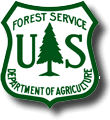United States
Department of
Agriculture
Forest Service
Rocky Mountain
Research Station
Ft. Collins, CO
General Technical Report
RMRS-GTR-118-CD
February 2004
| Authors |
| Acknowledgments |
| Introduction |
| Species description format |
| Trees |
| Shrubs |
| Ferns & Friends |
| Forbs |
| Graminoids |
| Descriptive drawings |
| Collecting and pressing methods |
| Glossary |
| References |

FAMILY Tribe (B)
Genus specific epithet Authorship (C)
Standard vegetation code (D)
common name or names
Form: Lifeform or habit with general description of height and roots.
National or Idaho Champion: Record tree measurements and general location (E).
Stems: General characteristics (F) and measurements (G).
Bark: General characteristics (F) and measurements (G).
Buds: General characteristics (F) and measurements (G).
Bundle Scars: General characteristics (F) and measurements (G).
Leaves: General characteristics (F) and measurements (G).
Flowers: General characteristics (F) and measurements (G).
Sporangium: General characteristics (F) and measurements (G) used to describe the reproductive structures in Ferns and Friends.
Inflorescence: General characteristics (F) and measurements (G) used to describe graminoids.
Cones: General characteristics (F) and measurements (G).
Fruit: General characteristics (F) and measurements (G).
Enemies: List of common injurious diseases and insects in order of decreasing damage potential. A generalized detrimental or advantageous response to fire (H).
Similar Species: List of easily confused genus and species.
Habitat: General site characteristics (J).
Notes: Special interest items (K).
Constancy Table: A table of constancy by habitat type for each species is included along the inner margin (L).
(A) The species description layout was patterned after a similar description layout in Randall and Keniston (1968). The text and terminology style was patterned after the above cited plant taxonomies. Line drawings used throughout the guide are from Hitchcock and others (1955-1969), Hayes and Garrison (1960), and Anon. (1981). Additional drawings were provided by people listed in the acknowledgments. Scale perspective is provided by a six foot tall forester standing next to a typical plant.
(B) The family is from Cronquist (1981). GRAMINEAE tribes are from Hitchcock (1971).
(C) The authority used for species authorship was Hitchcock and Cronquist (1973).
(D) Standardized vegetation codes are from Garrison and others (1976). These codes facilitate species field data entry and data exchange between agencies. This system uses the first two letters of the genus and specific epithet to create a 4-letter code, such as Asca for Asarum caudatum. In cases of duplication a suffix number is added, e.g. Asca3. A variety is designated by the addition of the first letter of the varietal name; for example, Spiraea betulifolia var. lucida becomes Spbel. Genera are designated by a code of the first 5 letters or less being all capitalized, such as SPIRA, ACER, POA. Common names follow Hitchcock and Cronquist (1973), Garrison and others (1976), or the most descriptive local usage.
(E) All wild and cultivated trees in Idaho are eligible to be measured for determination of the largest tree of each species or variety. The scoring for record trees is based on the formula: circumference (inches) + height (feet) + one-fourth the average crown diameter (feet). For a complete list of current record trees and forms explaining the process for nominating new record trees, contact:
Ron Mahoney
Idaho Big Tree Program Director
P.O. Box 441140
University of Idaho
Moscow, ID 83843-1140
(208) 885-6356
(F) General characteristics were condensed from several taxonomic treatments (Davis
1952, Hayes 1960, Hitchcock 1971, Hitchcock and others 1955-1969, Hitchcock and Cronquist
1973, Lee and Pfister 1978).
Hitchcock and Cronquist (1973) was used as the authority.
General field identification characteristics have been supplied by many individuals (see the acknowledgments).
A glossary of taxonomic terms is included at the end of the guide.
(G) The measurements are general ranges, not absolutes. The conversions from metric to English have been rounded for ease of use. Very small measurements (less than 1 inch) are given in metric only.
(H) More complete lists of species and related data can be found in: Diseases: Bega (1978), Fowells (1965), Hepting (1971), Partridge and others (1978), Partridge and Miller (1974). Insects: Partridge and others (1978), Fowells (1965), and Furniss and Carolin (1977). Fire: DeByle (1981), and Volland and Dell (1981).
(I) SIMILAR SPECIES lists other genera and/or species that can be easily confused with the one being described. Useful differentiating characteristics are included in commas. Similar species described in this guide are referenced by page number; species not included have their common names in parentheses.
(J) Site characteristics are given for a species when it generally occurs in a specific type of habitat in northern Idaho. The characteristics have been extracted from the previously mentioned references or from the authors' and contributors' experience within northern Idaho.
(K) NOTES contain items of common interest, species variation, or special botanical interest. References are made to species on the Idaho State Watch List, which, due to their rarity or limited distribution, are being monitored. You can learn more about watch lists, as well as threatened and endangered species, by visiting the Idaho Conservation Data Center's web site at <www2.state.id.us/fishgame/info/cdc/cdc.htm>.
(L) The habitat type constancy table shows the percentage of stands within a habitat type in which one can expect to find the species described. The list of habitat types and constancy values comes from Cooper and others (1983). Habitat types and phases with incidental occurrence in northern Idaho have not been included. The habitat types and phases are ordered from top to bottom along a generalized environmental gradient of hot-dry to cold-wet. The constancy values are given for midseral to climax stand conditions. Most species have different occurrences and constancy in highly disturbed habitats.
Constancy codes
Entry Occurence Not found + Trace 1 10% 2 20% 3 30% 4 40% ... ... 10 100%